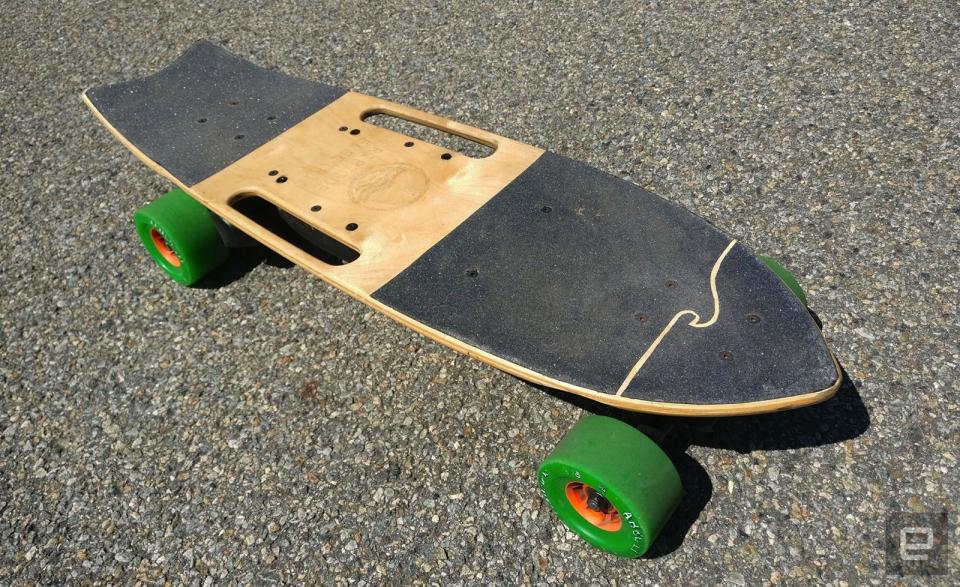Riptide's electric skateboard balances power and portability
The R1 is fast out of the gate, with the maneuverability of a standard-size deck.
Electric skateboards have been coming out of the woodwork lately, popping up in all shapes and sizes, with each new company trying to find a niche in the market. There have been examples of extremely tiny models accentuating portability and longboards with hyperextended ranges. It depends on what fits your use case, but I've been eyeing boards that match normal decks for scale, along with a belt-driven motor and a relatively affordable price. The newest entry to hit the crowdfunding scene is the Riptide R1, which dropped on Indiegogo today. So far, it's come closest to what I've been looking for on all fronts: size, price and power.
The great thing about having a shorter deck and some kicktail as opposed to the popular longboard designs is maneuverability. You can make far sharper turns and adjust your direction using the tail on boards like the 31-inch Riptide R1. While the popular Boosted Boards line may be the limo of electric rides, a smaller format is preferable when it comes to tight turns, which helps in a fragmented cityscape like New York. The R1 also has handle cutouts on both sides of the deck, making it easy to pick up and carry when you're not cruising. The board may not be as light as they come, weighing around 13 to 14 pounds, but when handles are added, it seemingly lightens the load.
When it comes to power, Riptide gives Boosted's boards a run for their money, all at a lower price. As a comparison, Boosted has 1,500- and 2,000-watt belt-drive longboard models ranging from $1,300 to $1,500. The Riptide R1 falls smack in the middle with 1,800 watts of belt-driven power, starting at a retail price of $749. However, that doesn't even include crowdfunded early-bird pricing, which is available now, starting at $499 for the basic R1 model and $629 for the R1 Elite.
Both versions of the R1 have the same deck, trucks and motor assembly. The standard R1 has blue 83MM / 78A wheels, while the R1 Elite package includes an additional set of taller (and softer) green 90MM / 75A wheels, plus a set of lights for the front and rear of the board. Those would be Shredlights, truck-bolt-mounted skateboard lights that helped Riptide founder Eric Birkemeier get his start.

As usual, there's a handheld controller to manage speed and braking. There's a ring grip for your finger, helping to keep it in your hand and a battery-level indicator on the side, and the unit is rechargeable via USB. You get both a standard mode and pro mode, letting you decide whether to cap your top speed at 12MPH or get the full top speeds of either 18 or 20MPH, depending on which model you get.
The regenerative braking works well, perhaps even too well if you're familiar with some other models that ease into a stop. Riptide boards currently brake a bit more quickly but seem easy enough to get familiar with, and as a brakes go, they have a lot of stopping power. There's also another button on the side for toggling into reverse mode. It would have been preferable to have braking and reverse bundled into the throttle lever as a single function, but I've rarely used reverse unless I overshot a crosswalk at a stoplight and wanted to back it up a bit.
The R1 boards have a range of up to seven or eight miles depending on which model you use, which is comparable to many boards, especially smaller decks with less space for large batteries. Since you're not pushing around, riding for distances greater than that in one go can tend to cramp up your legs, at least in my experience. Greater range is always a benefit, but chargers are light enough to chuck in a backpack when you need to re-up. As for pushing when the battery is dead? Like many belt-drive models, you can push around, but there is a little bit of resistance if you're on flat ground or vertical inclines, which is one area that hub motors do improve on.

Like most models on the market, the battery takes about three hours to fully charge, unless you splurge for the fast charger; then you can get juiced up and ready to go in 90 minutes. (If you can swing it, the fast charger is a must-have for any board.) While you'll technically be able to swap batteries, it's not a hot swappable setup, so you'd literally be unscrewing the pack to install a new one. The battery pack is made up of 3.6v 18650 Li-on cells and provides a total of 97.2Wh worth of juice, all UL approved. Riptide also notes that this <99 watt-hour rating makes it safe for air travel as well.
If you consider the early-bird pricing, this is a great deal for a board with this amount of power. Even at full retail pricing, it's comparable to boards like the Elwing, which also has a standard-size deck but uses a less robust (albeit more efficient) hub motor. The Riptide R1 Elite prototype that I tested was easy to get up to full speed quickly, and braking was smooth (once you get used to its rapid slowdown abilities). While being higher off the ground with the larger 90mm Elite series wheels may put a kink in your ollie ability -- something I've increasing found to be irrelevant for enjoying electric models -- they provide a smooth and stress-free ride.
The Riptide R1 and R1 Elite models are live on Indiegogo starting today with early-bird prices ranging from $499 to $629.





















